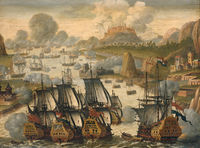Annotation:Vigo (2): Difference between revisions
No edit summary |
m Text replacement - "garamond, serif" to "sans-serif" |
||
| Line 1: | Line 1: | ||
=='''Back to [[{{BASEPAGENAME}}]]'''== | =='''Back to [[{{BASEPAGENAME}}]]'''== | ||
---- | ---- | ||
<p><font face=" | <p><font face="sans-serif" size="4"> | ||
'''VIGO.''' AKA - "St. Mary's Port." English, Country Dance Tune (6/8 time). G Major. Standard tuning (fiddle). AABB. The tune was published in all four editions of John Young's '''Second Volume of the Dancing Master''' [http://www.izaak.unh.edu/nhltmd/indexes/dancingmaster/Dance/Play5567.htm] (1710-1728), and in rival publishers Walsh and Randall's '''The New Country Dancing Master, Second Book''' (1710) and Walsh and Hare's ''' Second Book of the Compleat Country Dancing-Master''' (1719). "[[Vigo (1)]]" is a different tune, with different dance figures. | '''VIGO.''' AKA - "St. Mary's Port." English, Country Dance Tune (6/8 time). G Major. Standard tuning (fiddle). AABB. The tune was published in all four editions of John Young's '''Second Volume of the Dancing Master''' [http://www.izaak.unh.edu/nhltmd/indexes/dancingmaster/Dance/Play5567.htm] (1710-1728), and in rival publishers Walsh and Randall's '''The New Country Dancing Master, Second Book''' (1710) and Walsh and Hare's ''' Second Book of the Compleat Country Dancing-Master''' (1719). "[[Vigo (1)]]" is a different tune, with different dance figures. | ||
<br> | <br> | ||
| Line 16: | Line 16: | ||
<br> | <br> | ||
</font></p> | </font></p> | ||
<p><font face=" | <p><font face="sans-serif" size="4"> | ||
''Source for notated version'': | ''Source for notated version'': | ||
<br> | <br> | ||
<br> | <br> | ||
</font></p> | </font></p> | ||
<p><font face=" | <p><font face="sans-serif" size="4"> | ||
''Printed sources'': | ''Printed sources'': | ||
<br> | <br> | ||
<br> | <br> | ||
</font></p> | </font></p> | ||
<p><font face=" | <p><font face="sans-serif" size="4"> | ||
''Recorded sources'': <font color=teal></font> | ''Recorded sources'': <font color=teal></font> | ||
</font></p> | </font></p> | ||
Latest revision as of 14:41, 6 May 2019
Back to Vigo (2)
VIGO. AKA - "St. Mary's Port." English, Country Dance Tune (6/8 time). G Major. Standard tuning (fiddle). AABB. The tune was published in all four editions of John Young's Second Volume of the Dancing Master [1] (1710-1728), and in rival publishers Walsh and Randall's The New Country Dancing Master, Second Book (1710) and Walsh and Hare's Second Book of the Compleat Country Dancing-Master (1719). "Vigo (1)" is a different tune, with different dance figures.

The city of Vigo, Spain, is located on the coast in the Galician province of Pontevedra. Vigo Bay was the location of a naval battle in 1702 [2] that pitted the Anglo-Dutch forces of Admiral George Rooke (1650–1709) against the French and Spanish fleet that was protecting the Spanish treasure ships, arrived from America. The engagement was a success for Rooke, who captured or disabled all the opposing ships, although most of the treasure had already been off-loaded. Vigo Bay was hailed as a major victory in England, and was a cause of the Portuguese entering the Grand Alliance.
The alternate title may refer to the plundering of St. Mary's Port, near Cadiz, Spain, in 1702 by Sir Henry Belasyse (or Bellasis, 1648-1717) and Sir Charles O'Hara, English adventurers, for which the pair was tried; Belasyse was dismissed from service and O'Hara acquitted. Despite his tarnished reputation, Belasyse seems to have recovered in the next decade, for he was subsequently elected a member of Parliament for the city of Durham, appointed to a mission of inquiry by Queen Anne, and in 1713 he was appointed governor of Berwick. O'Hara became commander-in-chief of the British forces in Ireland.
There is also a gate ('port') in Edinburgh that was originally named Kirk of Field Port, from its proximity to St. Mary's in the Field, but was called St. Mary's Port through its associations with the church. Later it would be called Potterrow Port due to the many pottery or earthenware manufactures in the area.
Source for notated version:
Printed sources:
Recorded sources:

